
(a.)
The value of
(a.)
Answer to Problem 63E
It has been determined that
Explanation of Solution
Given:
graphed as follows:
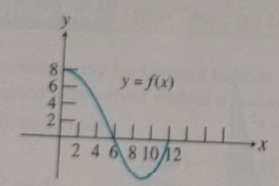
Concept used:
Calculation:
It is given that
Put
As discussed,
Put
Put
Conclusion:
It has been determined that
(b.)
The interval in which the function
(b.)
Answer to Problem 63E
It has been determined that the interval in which the function
Explanation of Solution
Given:
graphed as follows:
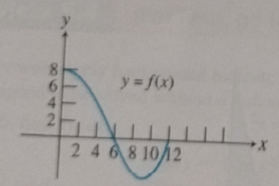
Concept used:
A function
Calculation:
It is given that
According to the definition of definite integral,
Moreover, according to convention, the area above the
It can be seen that the area under
This implies that
Conclusion:
It has been determined that the interval in which the function
(c.)
The interval in which the graph of
(c.)
Answer to Problem 63E
It has been determined that the graph of
Explanation of Solution
Given:
graphed as follows:
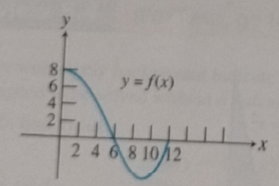
Concept used:
A function is concave up in the interval where its second derivative is positive.
Calculation:
It is given that
According to the Fundamental Theorem of Calculus,
Differentiating,
Now, the graph of
Equivalently, the graph of
So, the graph of
It can be seen from the given graph that
Then, the graph of
Conclusion:
It has been determined that the graph of
(d.)
If
(d.)
Answer to Problem 63E
It has been determined that
Explanation of Solution
Given:
graphed as follows:
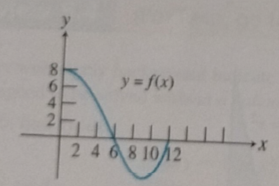
Concept used:
A definite integral of a function is the area under the curve of the function in the given interval.
Calculation:
It is given that
Put
This implies that
Now, the area above the
It can be seen from the given graph that the area under the curve of
However, it can also be seen that the magnitude of the positive area under the curve of
Then, the sum of these areas, which is the area under the curve of
Hence,
Conclusion:
It has been determined that
(e.)
The point where
(e.)
Answer to Problem 63E
It has been determined that
Explanation of Solution
Given:
graphed as follows:
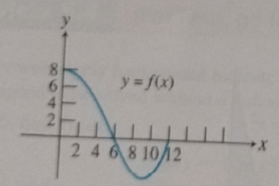
Concept used:
A function attains its maximum value at the point where it changes from being increasing to decreasing.
Calculation:
It is given that
According to the definition of definite integral,
Moreover, according to convention, the area above the
It can be seen that the area under
This implies that
As determined previously,
As determined previously,
Combining, it follows that
Conclusion:
It has been determined that
(f.)
The point where
(f.)
Answer to Problem 63E
It has been determined that
Explanation of Solution
Given:
graphed as follows:

Concept used:
A function attains its minimum value either at the end points or at the point where it stops being a decreasing function.
Calculation:
It is given that
According to the definition of definite integral,
Moreover, according to convention, the area above the
It can be seen that the area under
This implies that
As determined previously,
As determined previously,
Combining, it follows that
Conclusion:
It has been determined that
Chapter 5 Solutions
Advanced Placement Calculus Graphical Numerical Algebraic Sixth Edition High School Binding Copyright 2020
 Calculus: Early TranscendentalsCalculusISBN:9781285741550Author:James StewartPublisher:Cengage Learning
Calculus: Early TranscendentalsCalculusISBN:9781285741550Author:James StewartPublisher:Cengage Learning Thomas' Calculus (14th Edition)CalculusISBN:9780134438986Author:Joel R. Hass, Christopher E. Heil, Maurice D. WeirPublisher:PEARSON
Thomas' Calculus (14th Edition)CalculusISBN:9780134438986Author:Joel R. Hass, Christopher E. Heil, Maurice D. WeirPublisher:PEARSON Calculus: Early Transcendentals (3rd Edition)CalculusISBN:9780134763644Author:William L. Briggs, Lyle Cochran, Bernard Gillett, Eric SchulzPublisher:PEARSON
Calculus: Early Transcendentals (3rd Edition)CalculusISBN:9780134763644Author:William L. Briggs, Lyle Cochran, Bernard Gillett, Eric SchulzPublisher:PEARSON Calculus: Early TranscendentalsCalculusISBN:9781319050740Author:Jon Rogawski, Colin Adams, Robert FranzosaPublisher:W. H. Freeman
Calculus: Early TranscendentalsCalculusISBN:9781319050740Author:Jon Rogawski, Colin Adams, Robert FranzosaPublisher:W. H. Freeman
 Calculus: Early Transcendental FunctionsCalculusISBN:9781337552516Author:Ron Larson, Bruce H. EdwardsPublisher:Cengage Learning
Calculus: Early Transcendental FunctionsCalculusISBN:9781337552516Author:Ron Larson, Bruce H. EdwardsPublisher:Cengage Learning





